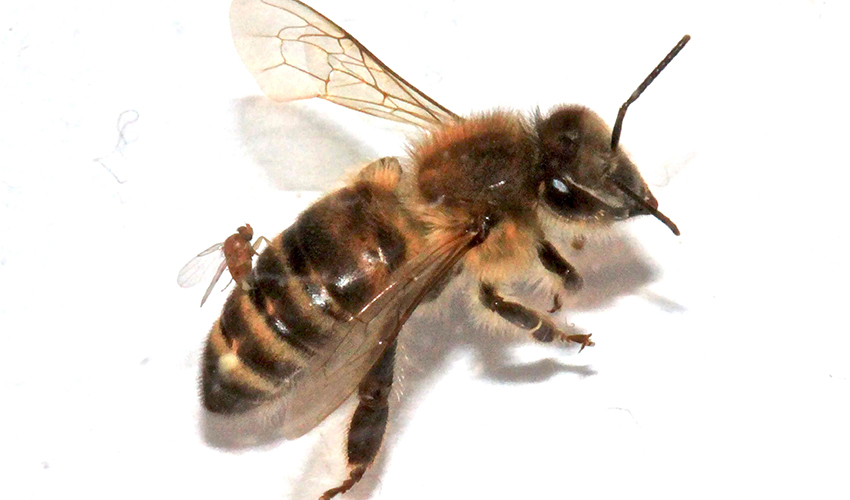SF State researchers confirm first 'zombie bee' sightings in Southern U.S.

An Apocephalis borealis female oviposits on bee. After being infected by the fly parasite, bees abandon their hives to congregate at night near lights, dying after a bout of disoriented, "zombie-like" behavior. Researchers at SF State confirmed this week the first "zombie bee" discovery in the southern United States. Photo credit: Christopher Quock
Parasitized honey bees discovered in Collinsville, Virginia; 'zombee hunters' needed nationwide
SAN FRANCISCO, June 22, 2016 – Parasitized honey bees, or "zombees," have been found for the first time in the Southern United States, according to researchers at San Francisco State University. The discovery, made in Collinsville, Virginia, was announced this week by ZomBee Watch, a project based at the University.
SF State Professor of Biology John Hafernik and his colleagues first reported parasitized honey bees in 2012 in an article in the journal PLOS ONE. After being infected with a fly parasite, the bees abandon their hives to congregate at night near lights, dying after a bout of disoriented, "zombie-like" behavior. Hafernik and other researchers are tracking the phenomenon with the help of more than 2,000 citizen scientists who report possible parasitized bee sightings to ZomBee Watch.
Early zombee sightings were mostly limited to the U.S. West Coast and South Dakota, but the latest discovery adds to the mounting evidence that the phenomenon is widespread on the East Coast as well. Parasitized bees were found for the first time in New England in 2013, followed by the mid-Atlantic region and upstate New York in 2014 and 2015, respectively.
"The important next steps are to determine how common the phenomenon is in Eastern honey bees, whether it might be spreading and increasing in intensity and how serious it is for the health of honey bee colonies," Hafernik said.
In order to do that, Hafernik is urging more individuals to join the zombee hunt to help researchers collect more data regarding the spread of zombie bees. He and his team have developed a series of videos to help new hunters get started, and Hafernik says now is the ideal time to get involved.
"We expect that infection rates will rise during the summer and peak in the fall," he said. "We are already receiving reports of honey bees being hard hit this year in the Hudson Valley of New York. More than ever, we need citizen scientists to join the ZomBee Watch team, to be on the lookout for honey bees acting strangely in their area and report their observations."
The Virginia bees were discovered by Collinsville beekeeper Lynn Berry earlier this spring. Berry had noticed bees congregating near his garage lights, but thought nothing of it until a state inspector came to a meeting of the local beekeeping club and told attendees about the zombee phenomenon. Berry collected his samples and sent them to Brian Brown, a phorid fly expert at the Natural History Museum of Los Angeles County, who confirmed that one had been infected by the Apocephalis borealis fly, the parasite behind the zombee infestations. The fly infects a honey bee by depositing its eggs into the bee's abdomen. A few days after the bee dies, fly larvae burst out from between the bee's head and thorax.
Although Berry was relieved that just one of the 10 bees he sent to Brown was infected, he hopes to raise awareness of this issue and get more of his fellow beekeepers involved in testing their bees.
"I feel like more people have [parasitized bees], they just don't realize they have them," he said.
Beekeepers who find their hives are infected should stay calm and use the best beekeeping practices to keep their hives as healthy as possible, as it is most likely that healthy hives are better able to survive infections from the phorid fly or any other pathogen, according to Hafernik.
Hafernik and his colleagues launched ZomBeeWatch.org in 2012 to encourage citizen scientists to report cases of parasitized bees, which were first discovered on the SF State campus. Since then, more than 200,000 people have visited the project's website and more than 2,663 zombee hunters have submitted some 834 samples to be tested for infestation. Roughly 25 percent of participants are beekeepers, and the rest are interested citizens doing their part to help track this new threat to honey bees.
###
San Francisco State University makes things happen. Founded in 1899, it is the only master's-level public university serving the counties of San Francisco, San Mateo and Marin. Its nationally acclaimed programs span a broad range of disciplines. Nearly 30,000 students enroll at the University each year, and its more than 236,000 graduates have contributed to the economic, cultural and civic fabric of San Francisco and beyond. Through them -- and more than 1,600 world-class faculty members -- SF State proudly embraces its legacy of academic excellence, community engagement and commitment to social justice. For more information, visit sfsu.edu.